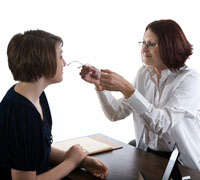
FIT FRAME, TAKE MEASUREMENTS
Proper frame fit begins with a proper adjustment. However, frames should look symmetric and "polished" when presented for trial and fitting. Frames on the shelves and in the cabinets should pass the "Four Points" test. Upside down, the frame should be level on a flat surface; meaning the right temple bend, left temple bend, top of the right and left eye wire are all touching the surface at the same time. This initial standard alignment is the starting point, but once you're ready to take measurements, be sure the frame is adjusted specifically for that patient—this decreases the chances of inaccurate measurements and fits, and is a simple way to eliminate measurement errors. Check the "Fitting Triangle," the three points where the frame sits on the bridge and on top of each ear. This ensures a securely and evenly fitted frame. If the frame has nosepads, check each of those as well to ensure they are in the proper place on your patient's nose.

Proper frame fit also means selecting the right size. A frame that's the wrong size for a patient could lead not only to discomfort and a possible frame exchange, but also to negative effects on the lenses themselves. Too small of a frame can decrease vision, especially in progressives. Too large of a frame can't hide peripheral distortion, particularly in high astigmatic prescriptions and progressives. A frame requiring lenses with a base curve exceeding 6 may also create distortion unless the right optimized lenses from a digital lab or authentic wrap Rx eyewear is ordered from the manufacturer (Oakley, Maui Jim, Rudy Project, etc.).
Part Four of this series provides valuable advice for reducing remakes by a careful evaluation of the patient's habitual glasses.

Bethany DeWolfe, ABOC is an optician in Greensburg, Pa. She joined the optical industry 10 years ago, training under Pittsburgh's optical elite. She is currently managing an independent optical store specializing in unique frame selection and quality on-site lab work.












